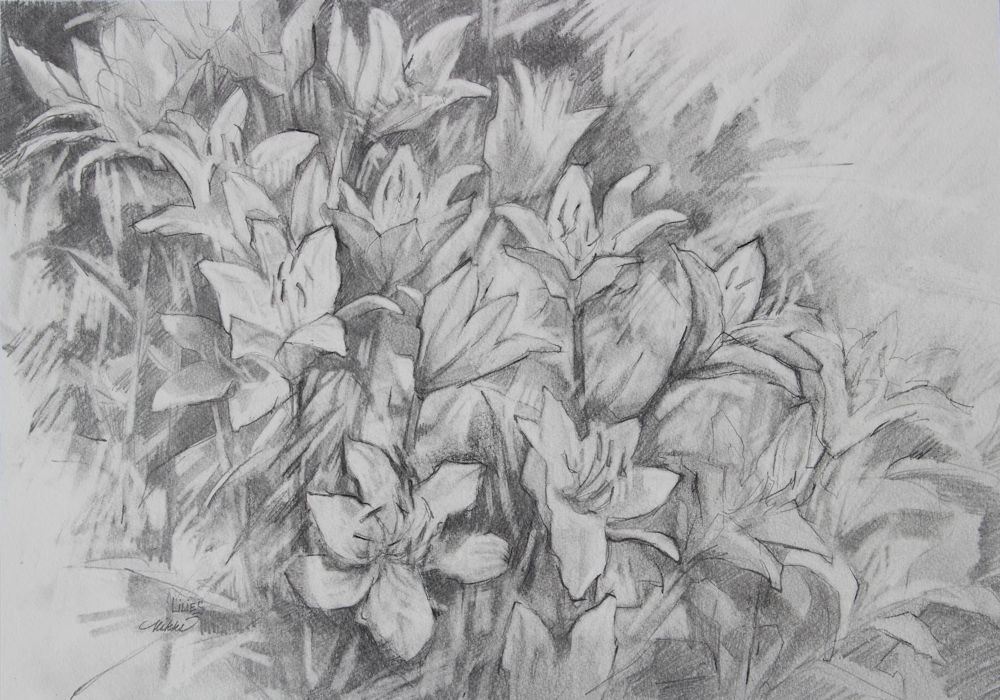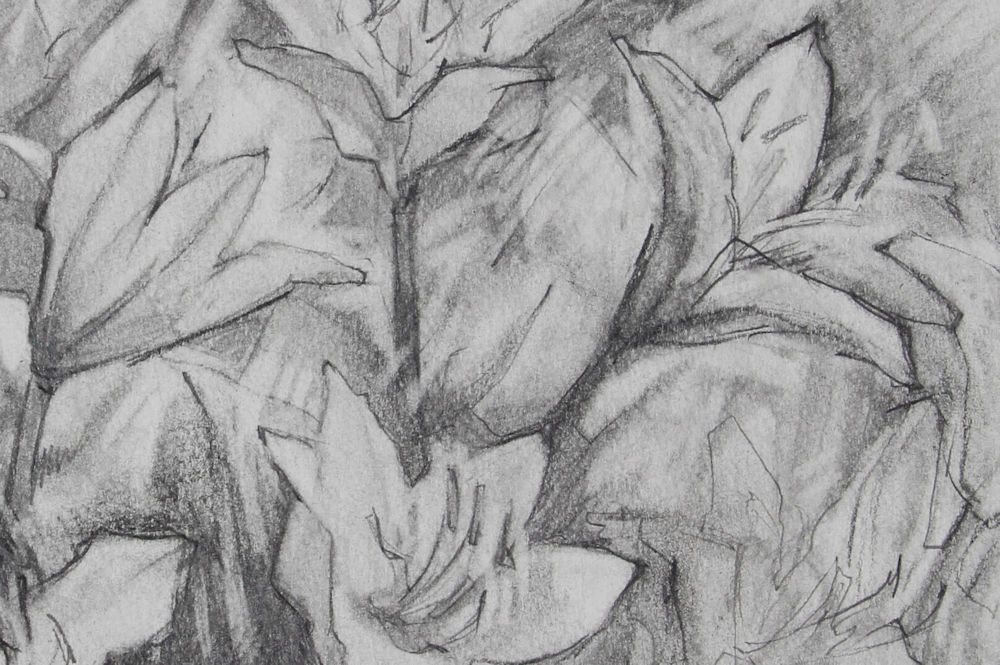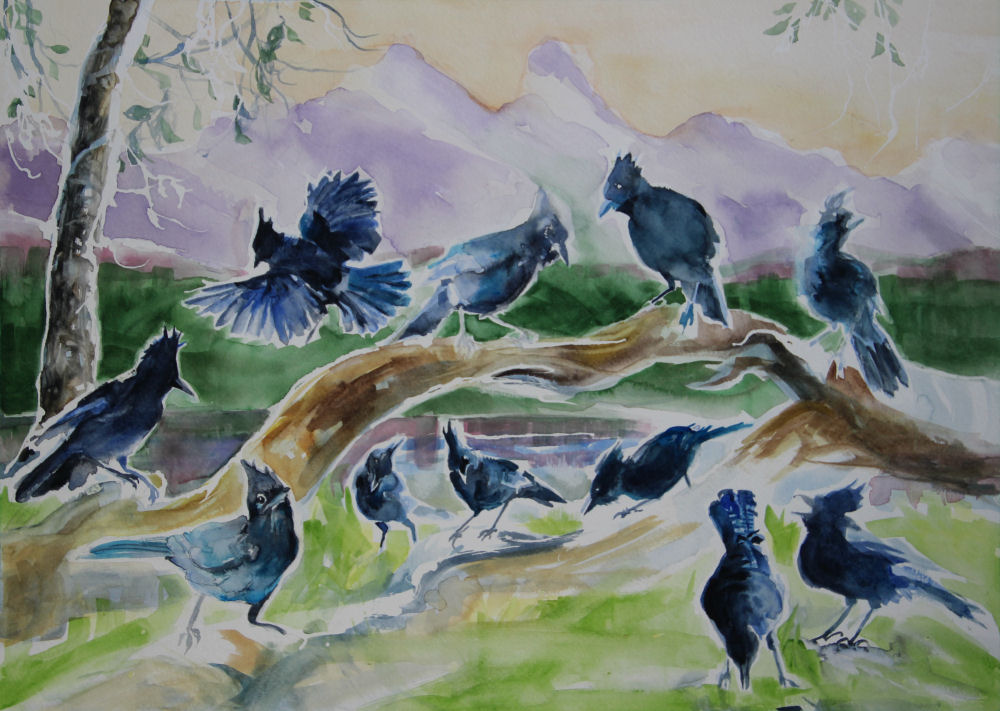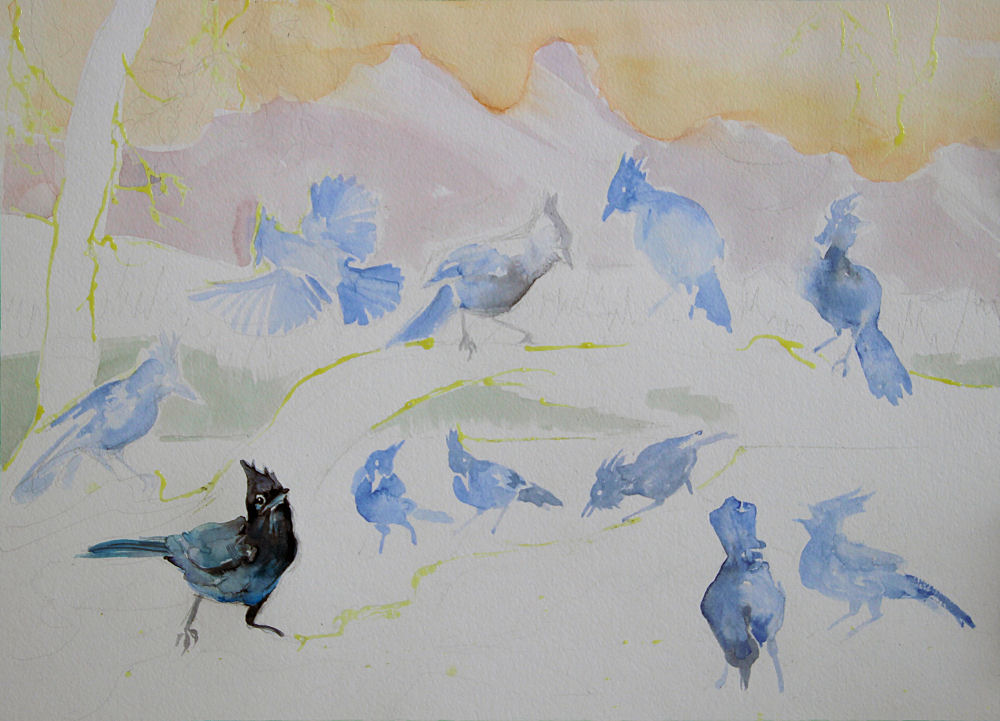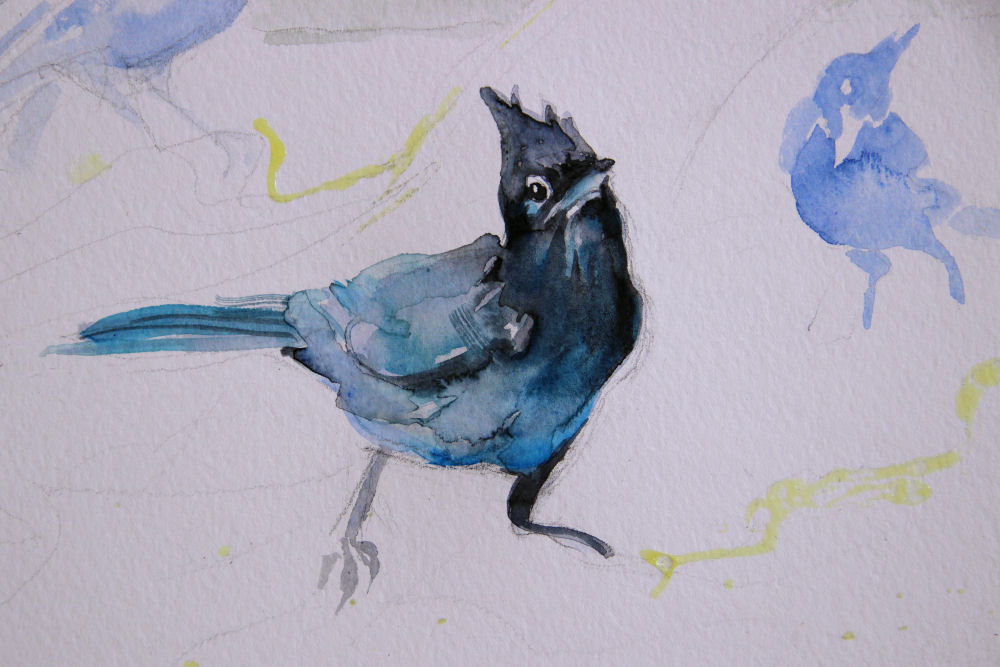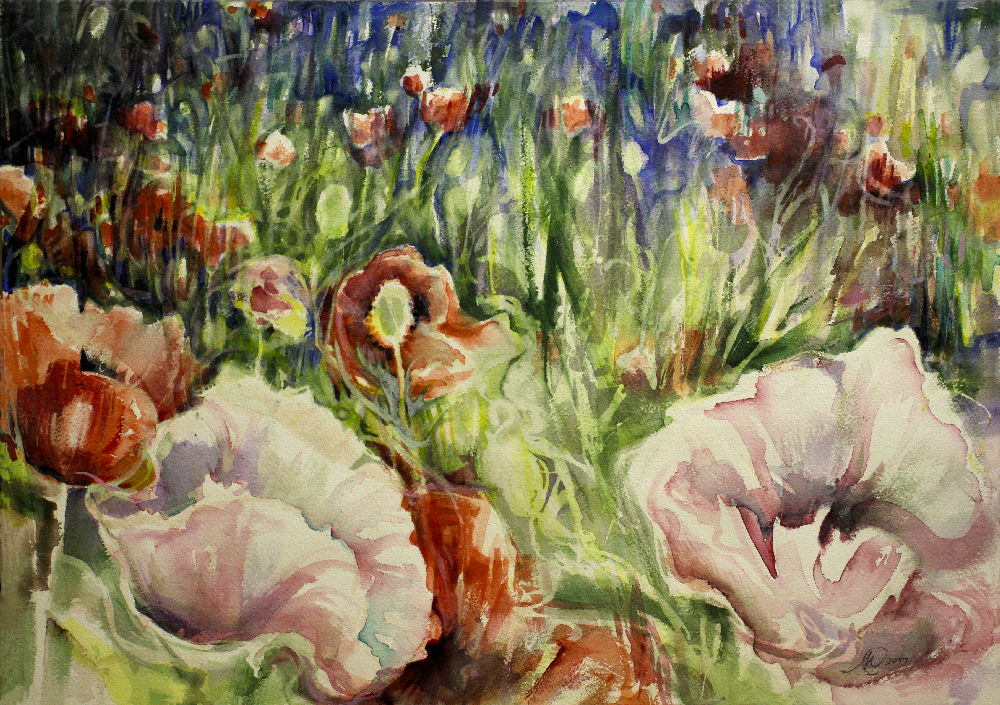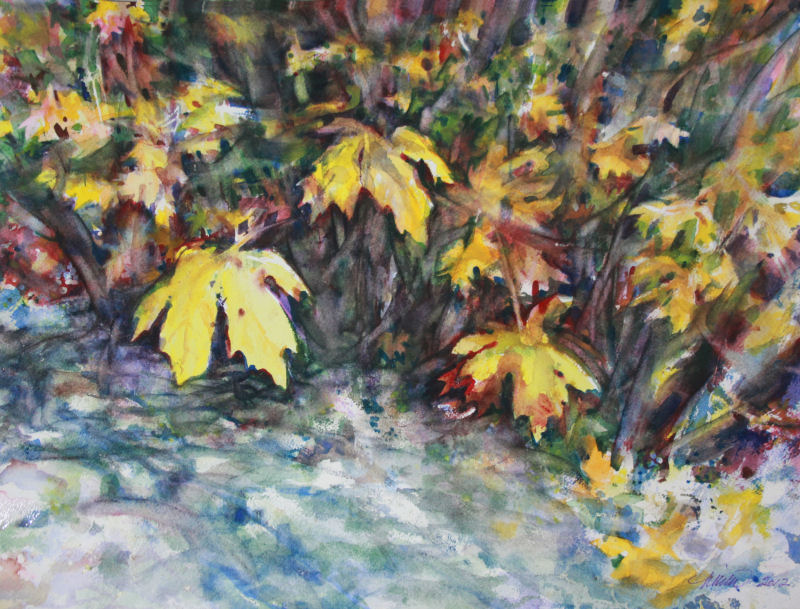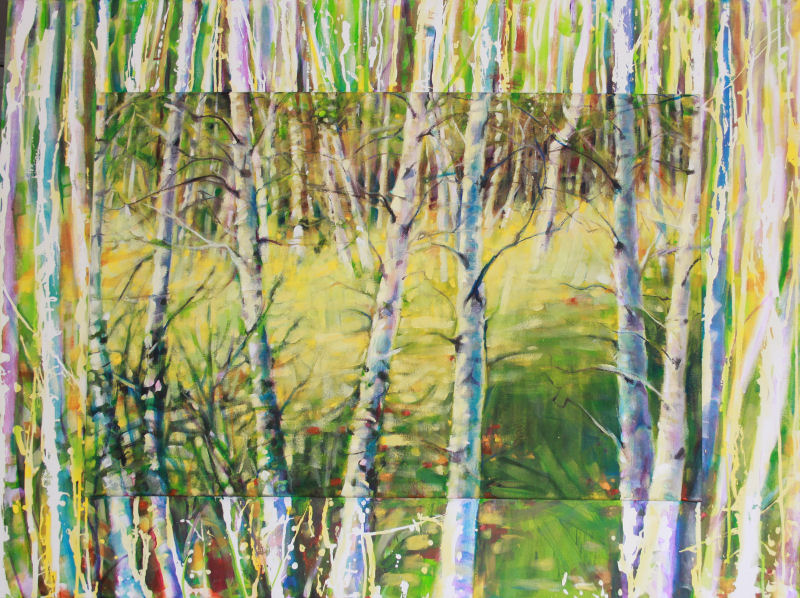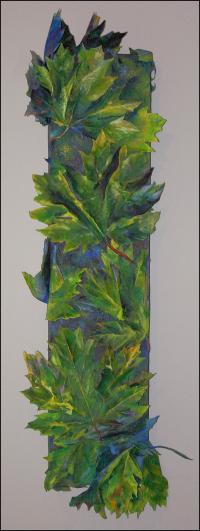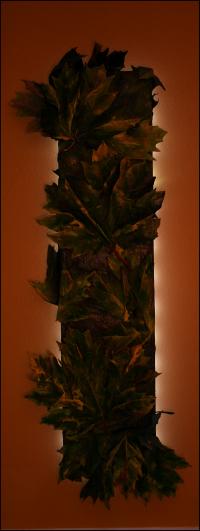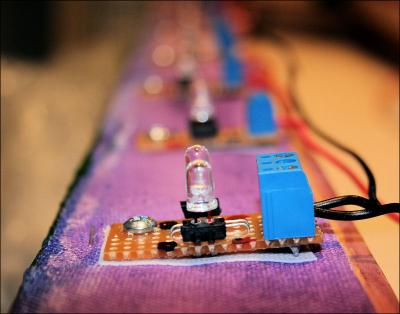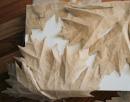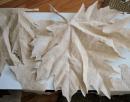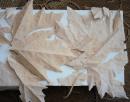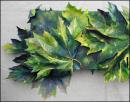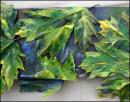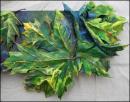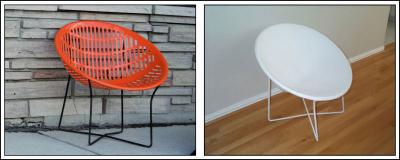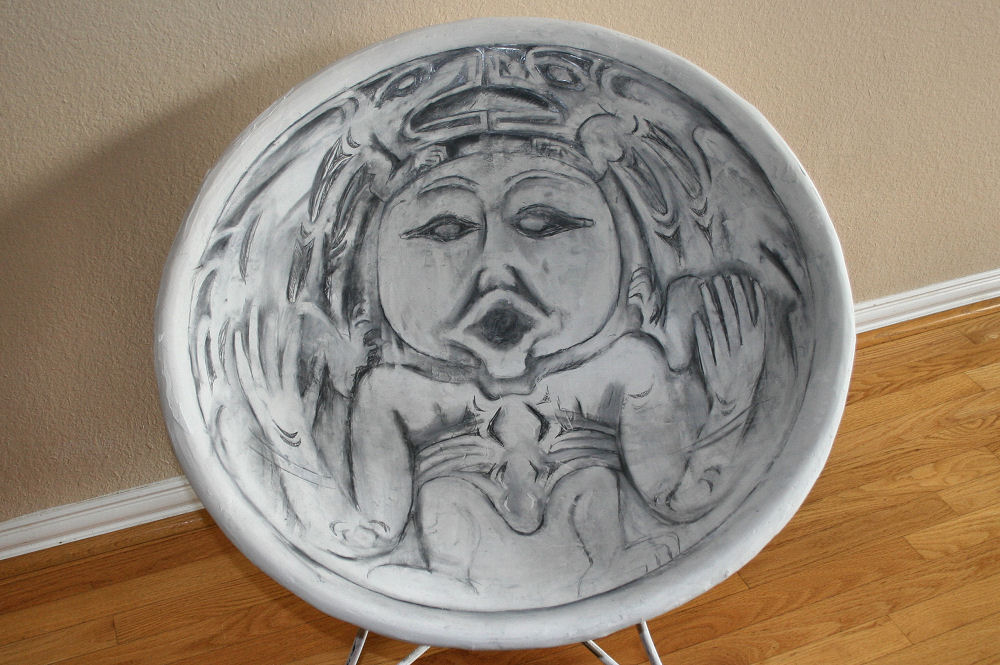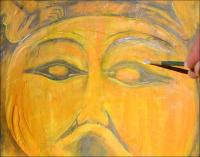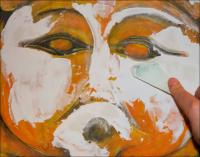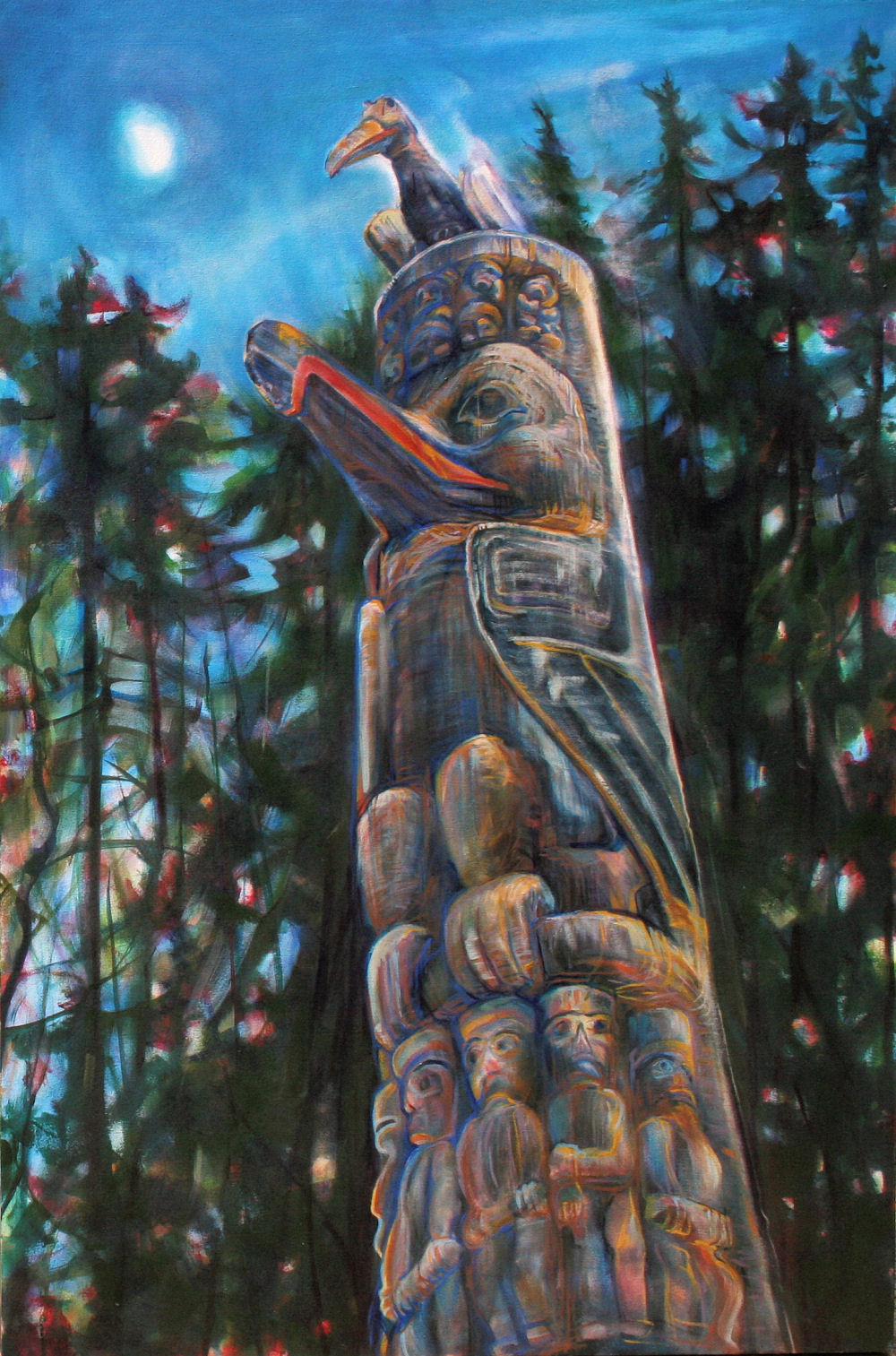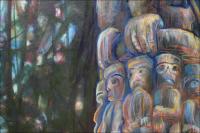B.C.
« Previous Entries Next Entries »Nimkish Lake Sunset
Sunday, July 7th, 2019
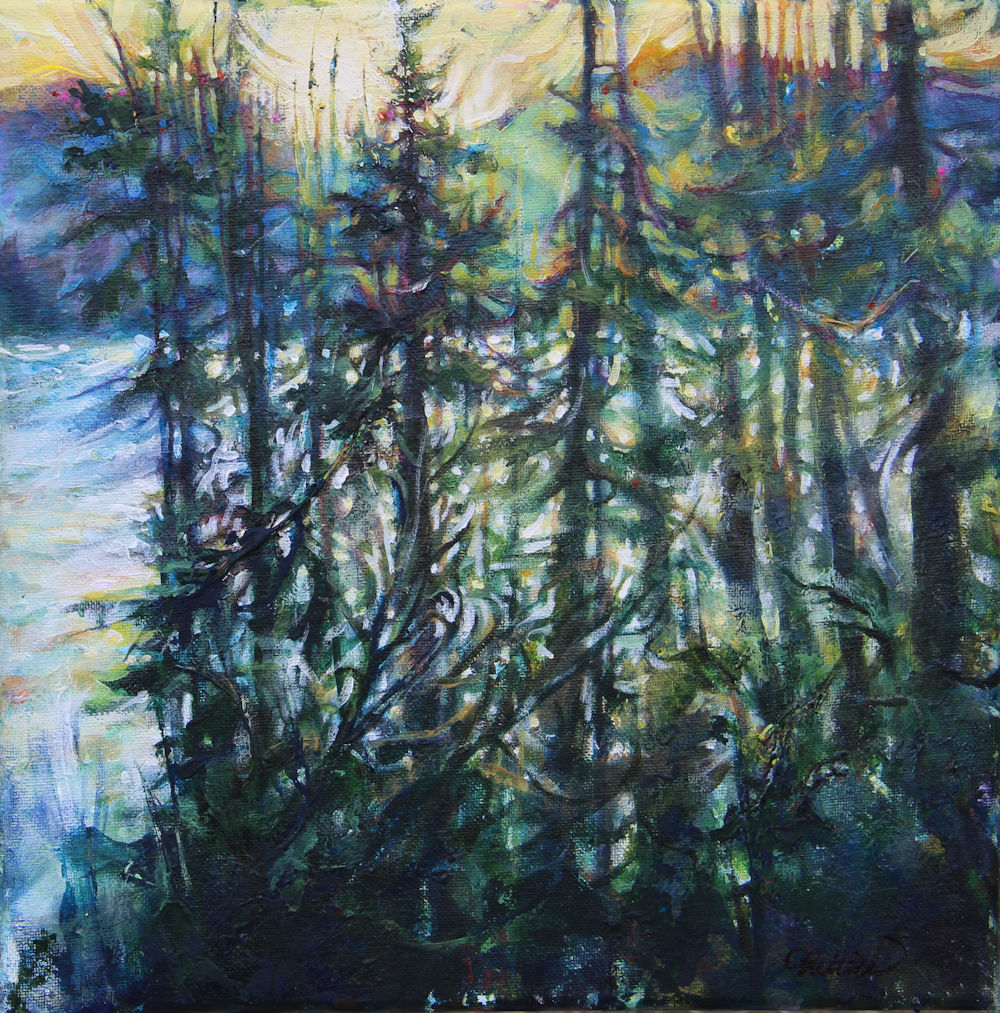
Nimkish Lake Sunset, 12 x 12 inches acrylics on canvas. Frame unnecessary.
Lilies at Butchart Gardens, BC
Sunday, August 5th, 2018
Lilies at the Butchart Gardens, Victoria BC, 18H x 24W inches graphite on 140 lb cold pressed premium. Detail image:
Stellar’s Jays finished
Friday, May 11th, 2018
Stellar’s Jays finished, Nimkish Lake campsite, Vancouver Island BC, 18H x 24W inches watercolors on 140 lb. cold pressed. Framed size 27H x 33W inches: white mat and white wood frame with crackle finish.
Stellar’s Jays are not seen in groups like this, perhaps only seen 3 together at most, so in that sense the portrayal is not accurate, but the aim here is to show a collage of 11 birds representing their distinct character.
Stellar’s Jays
Monday, April 17th, 2017
Work in progress, Stellar’s Jays at Nimkish Lake, Vancouver Island BC, 18 x 24 inches watercolors on 140 lb. cold press. For years I’ve been visualizing a painting that portrays the Stellar’s Jay in various poses, representing general character. My Dad pointed out that Stellar’s Jays don’t usually group this way, which is an accurate view of the broader behaviour that didn’t even occur to me. Interesting! Phase 02 below and detail image – the yellow is masking medium:
Normally I don’t outline anything when starting a painting, which works fine with acrylics because it’s easy to change things throughout the process, but watercolors don’t allow for much room for error, especially if you don’t have much practice with them. Wingin’ it usually works for me because I don’t mind failure in exchange for experience, but mapping out the shapes and arrangement lightly in pencil really helps, and confidence is fundamental to painting well.
North Saanich Poppies
Wednesday, February 22nd, 2017
North Saanich Poppies, BC Canada – 14H x 20W inches W/C on 140 lb. cold pressed premium. Framed size 20H x 26W inches with white mat, white wood frame with crackle finish.
Bigleaf Maple watercolors
Sunday, November 4th, 2012
Big Leaf Maple near Port Renfrew, Vancouver Island, BC Canada, 12H x 16W inches watercolors on 140 lb 100% cotton paper. Framed size 22H x 26W inches.
Framing on Northern Delights 02 update
Tuesday, December 14th, 2010
Northern Delights 02, 24H x 36W inches acrylics on canvas, adhered to a 36H x 48W x 1D inches canvas. Mask/resist medium was used to maintain white spaces and pure colors in both sections.
The central painting was started in 2006, and the framing was resolved today – a perfect example where some paintings just need to hang around for a while before they are well and truly finished. The scene of the central painting is extended onto the larger canvas, initially intended to have the same style. However, after stopping for a coffee break then coming back with fresh eyes, I actually like the clash of styles. I always say that art is the best place to exhibit any rebellious tendencies! Besides, formal frames can sometimes cut off the energy of a composition too abruptly. Every painting does not need a frame, but finishing the edges should always be considered.
What Bigleaf Maples Do At Night
Monday, May 25th, 2009
What Bigleaf Maples Do At Night, 57H x 20W x 4D inches muslin, glue, acrylics on canvas wrapped over custom-built stretcher frame. LED light system in back.
Alain, my husband, signed his name on this also, because he spent the entire week designing, soldering and wiring a system of 30 LED lights for the back. He was not impressed with the eight inadequate push-lights I was initially going to use to create this Day- Night Art. The electric source is a rechargeable 12 volt battery placed neatly in the back, with an easily accessible on-off switch in the lower left corner. He’s not thrilled to ever create another, so it looks like I’ll be learning a little about soldering and electronics, because there are plans to transform the other two canvases exactly the same size as this one. Originally l hoped it could hang in any of four orientations, but that was revised due the battery pack in the back. Thank you Alain for making this piece what it is!
______________________The original blog posts; process:___________________
Nov. 17th, 2008: While finishing the final stages of Sun Shower #4, at this point more study than stroke, I’ve started on the next piece… a bit of mystery thrown into this one just for fun. Hint: Step 1 – Unbleached muslin is painted with glue; place over top parchment paper and turn or lift frequently so it doesn’t stick. Nov. 18th: Step 2– When dry the muslin becomes stiff and can be crumpled, pinched and maneuvered to create 3D textures.
Nov 18th, aft. Step 3 – OK, enough guessing. I have three beautiful sturdy 36 x 12 x 3 inch canvases, hung vertically or horizontally. Each one will have a 3D design of life-sized leaves created with the stiff muslin. This one is of Large Leaf Maples seen on salt Spring Island, B.C. when we were there last summer. They are really this big – about 15 inches across! On these canvases, all dimensional surfaces will be considered; the front, the sides, and possibly some sticking out from the back. Everything will be primed before painting and I love Virginia’s idea to use glue as a resist for the leaf veins. In the above three images the design is still in planning stages.
Nov. 19th – A few thoughts before continuing work: this could be as simple as a sillhouette or painted realistically, still haven’t decided..maybe a compromise of the two, on the abstract side of things. Putting lights in the back could be interesting too, as in the recent Zen Garden #8 but would like to come up with something that does not have a distracting cord.
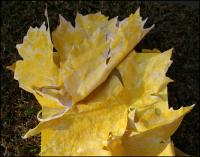 Nov.21st – Seen here, the leaves have a splotchy base coat of Hansa Yellow Deep, a color chosen because when it is so vibrant when it peeks through built up layers of other colors. Now that the entire piece has color though, I think I prefer the sculptural purity of the unpainted sillhouettes better – something to remember for similar work in the future.
Nov.21st – Seen here, the leaves have a splotchy base coat of Hansa Yellow Deep, a color chosen because when it is so vibrant when it peeks through built up layers of other colors. Now that the entire piece has color though, I think I prefer the sculptural purity of the unpainted sillhouettes better – something to remember for similar work in the future.
The weight of tinted primer and each application of acrylics makes the fabric limp from of the paint, meaning the creasing process needs to be done all over again once it dries, even on successive layers. Because of this I need to slow down and be more gentle with the painting process also. It’s funny how you can overlook things like that when you are ten steps ahead with anticipation for a new project; things always take much longer than you imagine. There is going to be a lot of stopping and starting with this one, which is exactly how overlapping projects occurs.
Also: looking forward to a day-long workshop tomorrow, learning about Encaustic painting with Deanna Wood. Encaustics is an ancient process of painting with beeswax and natural resins. Not usually a “workshop” kind of Artist because I’m too greedy with my work-time, but this is one of those things that’s best learned from an expert. Am bringing a fabric leaf to the class to see how it could be incorporated and if this entire. Large Leaf Maples piece could benefit.
______________________________
All posts and comments for this piece are now combined.
Submitted on 2008/11/18 at 11:48am
If you don’t want to see the seed bits in the muslin, you can get unbleached muslin without the seeds.
_______________________________
Submitted on 2008/11/18 at 1:03pm
OK Lynda, thanks for offering this valuable tip. With regard to what’s in mind for this project, the rawness of the fabric will provide extra texture, but others may want to know that finer quality muslin is available.
Nikki
_______________________________
Submitted on 2008/11/18 at 1:53pm
Hmmm…looks like a resist process to me. Is it a mask? You are a very adventurous soul!
Virginia Wieringa
_______________________________
Submitted on 2008/11/18 at 2:06pm
Nope, not a mask or resist…at least the glue wasn’t initially going to be used as a resist, but once again I owe thanks for the tip via a viewer’s comment – thanks Virginia! It’s true, glue can be used on anything as a paint resist, usually on wood it works similar to crackle glaze (ask me how if anyone is interested). I haven’t tried that technique on raw fabric yet though and for what I have in mind, painting extra glue in strategic places could produce some interesting effects. Let’s see…
Nikki
_______________________________
Submitted on 2008/11/19 at 1:16am
This is great Nikki. I’ll be back tomorrow to see how this project is coming along.
Jim Drury
_______________________________
Submitted on 2008/11/19 at 4:12pm
Hi Nikki
This is getting really interesting, can’t wait to see the finish project
Elizabeth
_______________________________
Submitted on 2008/11/19 at 7:07pm
Thanks for staying tuned Dad and Elizabeth, I also can’t wait to see the finished project – it’s always a mystery even if I think I know what I’m doing.
Nikki
_______________________________
Nov.27: What Large Leaf Maples Do At Night, detail images of 12 x 36 x 3 inches Muslin, glue, acrylics on wrapped canvas. As seen here I imagined the leaves glowing in the moonlight, which took me to the idea of turning it into a piece that can be viewed differently in a dark corner or at night so the sculptural sillhouette shows best.
Since Saturday’s Encaustics workshop I’d like to try another sculptural piece doing the whole thing with 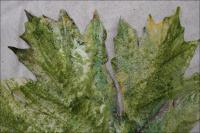 Encaustics tecniques, see right sample. Beeswax doesn’t adhere to acrylics though, so another will need to be planned with that medium in mind right from the start.
Encaustics tecniques, see right sample. Beeswax doesn’t adhere to acrylics though, so another will need to be planned with that medium in mind right from the start.
New chair started: Salish Wooden Whorl
Sunday, December 14th, 2008
This functional replica of a Salish Carved Wood Whorl re-utilizes a 1960’s plastic lawn chair, 29H x 29W x 29D inches that was considered Art in its own day. The refurbished chair has woven canvas strips and white glue applied paper-mache style over the entire plastic top and bottom. Multiple layers of wall plaster are sanded in between coats. The design is sketched with graphite then painted with acrylics, and drawing is continually adjusted as layering of materials continues.This is the second chair of four in the historic Art-themed series. The other two chairs are in the earlier stages of progress.
Going for the magic every hour
Friday, August 15th, 2008
Magic Hour finished (Gitxsan Totem Pole, Thunderbird Park, Victoria, BC Canada), 60H x 40W x 3D inches acrylics on canvas, sturdy home-built stretcher frame, wrapped sides painted, narrow trim frame. Here is an earlier post with information about this totem pole.
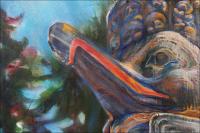 Great moments in painting are addictive, when so completely immersed in the work that time becomes non-existent… The Zone! I’ve had a good week with this one, partly because of getting past the habit of trying to control the outcome. Things happen in every painting that are not planned, and the endless choices are part of the fun.
Great moments in painting are addictive, when so completely immersed in the work that time becomes non-existent… The Zone! I’ve had a good week with this one, partly because of getting past the habit of trying to control the outcome. Things happen in every painting that are not planned, and the endless choices are part of the fun.
Painting is considered to be a two-dimensional undertaking, but it’s so much more. While lost in the work process, all the dimensions of the subject are explored, including the deeper dimensions of ourselves. While painting we discover our convictions and the means to ask how far we are willing to go to stand up for them.
Work every day is about continually reevaluating decisions, taking responsibility for choices made, being honest about mistakes, shortcomings and limitations of media and self, and digging deep to find compromise between technical and intuitive solutions. It’s about control of all those elements, combined with easing up on trying to control too much. All this and more translates onto a flat surface as we hope to give the illusion of depth…if that isn’t magic, I don’t know what is!
Post-dated Note: When choosing this totem pole that is erected in Thunderbird Park at the RBC Museum in Victoria, I didn’t realize that it’s the same one that Emily Carr painted in 1928. More magic! Here is a link to more information about this totem and the Gitxsan Poles moved from Gitanyow (formerly Kitwankool) B.C.
A word here about artists’ representation of First nations or any other cultural/historic works: subjects are painted with the greatest honor and respect, with purpose to study and draw interest to the importance of appreciating our multi-cultural world and the unique characteristics of each and every culture. This is what artists do. Our differences as cultures are connected across time and place, as there are many common traits and themes expressed through Art everywhere.
Robert Genn and readers of The Painters’ Keys have some very interesting comments all around the board about this topic.


